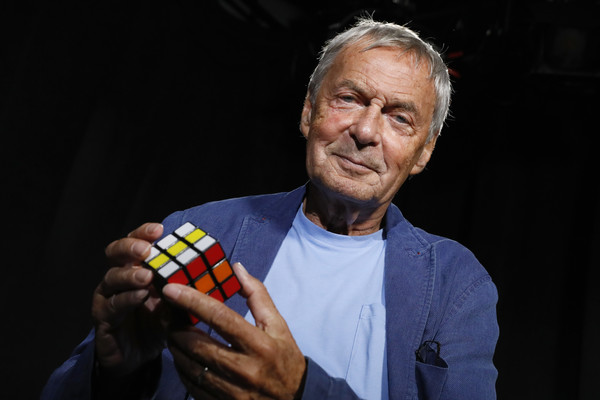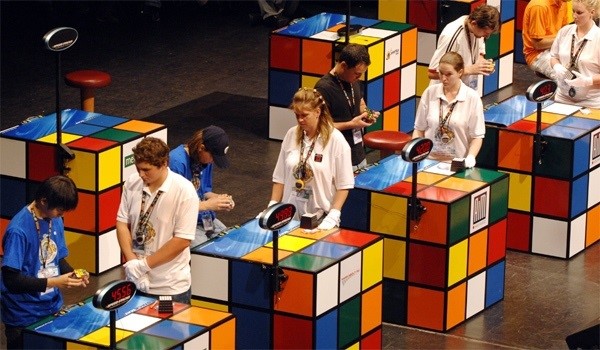Rubik’s Cube, the most well-known Hungarian invention

[아츠앤컬쳐] 오는 8월 중순 송도에서 2년마다 전 세계에서 수천 명의 경쟁자와 마니아들을 끌어들이는 루빅 큐브 월드챔피언십이 개최될 예정이다. 세계큐브협회는 140개국에 10만 명 이상의 경쟁자를 보유하고 있으며, 2004년 설립 이후 꾸준히 성장해 온 큐브 커뮤니티를 더욱 확대할 계획이다.
따라서 역대 가장 인기 있는 장난감 큐브에 얽힌 비하인드 스토리를 알아본다. 이 전설적인 퍼즐기구는 1974년 헝가리 건축가이자 교수인 에르노 루빅에 의해 발명되었다. 이 퍼즐은 비틀고 돌릴 수 있는 더 작은 큐브들로 구성된 큐브 모양의 구조로 되어 있다. 이 큐브 장난감의 목표는 큐브의 각 면에 무작위로 섞인 색상을 조합하여 각 면을 단일 색상으로 통일하는 것이다.
큐브 발명가인 에르노 루빅은 29세에 부다페스트 응용예술대학(현재 모호이 너지 예술디자인대학)의 조교수로 재직하면서 공간 움직임을 설명하고자 27개의 큐브로 구성된 3x3x3 버전을 만들었다. 이 버전은 큐브의 각 면이 중심을 중심으로 회전하도록 서로를 고정하는 특별한 조각 요소가 있다. 이 조각의 움직임을 추적하기 위해 그는 옆면을 다른 색상으로 표시했다. 이렇게 큐브는 교육용 교재로 제작되었는데, 곧 논리 퍼즐 게임으로 유명해졌다.

루빅스 큐브는 1980년대에 널리 퍼지며 인기를 얻었고 그 이후로 지금까지 4억5천만 개가 넘게 판매된 고전 퍼즐게임으로 남아 있다. 이 큐브는 논리적 사고, 문제 해결 능력, 그리고 해결을 위한 공간 인식이 필요하다. 큐브에는 총 4,300경 가지의 가능한 조합을 가지고 있어 마스터하기 어려운 퍼즐이다.
수년 동안 루빅스 큐브는 가능한 한 빨리 문제를 해결해내기 위한 수많은 대회, 이벤트 및 커뮤니티에 영감을 주었다. 알려진 대로 스피드큐빙은 가능한 한 최단 시간 내에 큐브를 해결하는 것을 포함한다. 여기에는 스피드큐버가 더 빠른 시간 안에 달성하기 위해 사용하는 다양한 해결 방법과 알고리즘이 존재한다.
지난 49년 동안 루빅스 큐브는 수백 편의 영화, 책, 만화에 등장하는 창의성, 혁신, 인내, 독창성의 상징이 되었다. 그것은 다양한 예술적 해석에 영감을 주었고 수학, 컴퓨터 과학 및 교육과 같은 분야에서 비판적 사고와 문제 해결 기술을 촉진하기 위해 사용되었다.
14명의 노벨상 수상자 또는 화이자의 코로나 백신을 만든 카탈린 카리코와 같은 연구원처럼, 루빅스 큐브 역시 헝가리가 낳은 훌륭한 상징 중 하나다. 따라서 서울에 있는 헝가리문화원의 다음 예술 프로젝트 중 하나는 큐브를 그리며 헝가리 창의성의 상징으로 에르노 루빅을 기리는 강남의 대규모 벽화가 될 것이다.


Rubik’s Cube, the most well-known Hungarian invention
In mid-August this summer Songdo hosts the Rubic Cube World Championship which attracts thousands of competitors and enthusiasts every second year from all over the world. The World Cube Association has had over 100,000 competitors across 140 different countries and they are even planning to widen the cubing community, which has been growing steadily since their founding in 2004.
But what is the story behind the – probably – most popular toy of all times?
The legendary mechanical puzzle was invented by Hungarian architect and professor Ernő Rubik in 1974. It consists of a cube-shaped structure made up of smaller cubes that can be twisted and turned. The goal is to arrange the colors on each face of the cube so that each face is a single color.

Ernő Rubik, the inventor of the cube, at the age of 29, as an assistant professor at the College of Applied Arts in Budapest - now Moholy-Nagy University of Art and Design - wanted to illustrate spatial movements. Thus was born the 3x3x3 version, consisting of 27 cubes, with specially carved elements that held each other together, making each side of the cube rotate around the center. In order to keep track of the movement of the elements, he marked the sides with different colors. Although it was designed for educational purposes, the cube became famous as a logic puzzle game.
The Rubik's Cube gained widespread popularity in the 1980s and has remained a classic puzzle with over 450 million cubes sold ever since. It requires logical thinking, problem-solving skills, and spatial awareness to solve. The cube has a total of 43 quintillion possible combinations, making it a challenging puzzle to master.

Over the years, the Rubik's Cube has inspired numerous competitions, events, and communities dedicated to solving it as quickly as possible. Speedcubing, as it is known, involves solving the cube within the shortest time possible. There are different solving methods and algorithms that speedcubers use to achieve faster times.
In the last 49 years, the Rubik's Cube has also become a symbol of creativity, innovation, perseverance, and ingenuity starring in hundreds of movies, books and comics. It has inspired various artistic interpretations and has been used in fields such as mathematics, computer science, and education to promote critical thinking and problem-solving skills.
The Rubik’s Cube is an excellent symbol of Hungary, that has given the world 14 Nobel laureates, or researchers such as Katalin Karikó who is behind Pfizer’s COVID vaccine. Therefore, one of the next artistic projects of the Hungarian Cultural Center in Seoul will be a large-scale mural painting in Gangnam, depicting the cube and honoring Ernő Rubik as a symbol of the Hungarian creativity.


글 | 언드라시 스츠 András Szűts
주한리스트헝가리문화원 부원장
Liszt Institute - Hungarian Cultural Center Seoul

